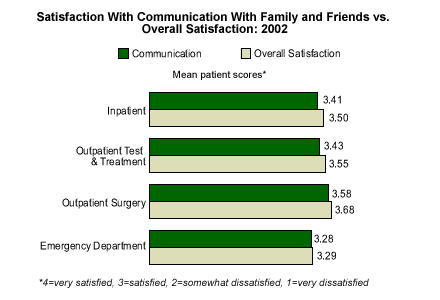Wander through any hospital and you'll see many stressed-out people who are neither patients nor staff members. They are the family members or friends of patients, and in many instances they are anxious about their loved one's condition and treatment. Uncertainty about a patient's status can exacerbate the stress these people feel, in part because many of them will play integral roles in caring for patients once they are discharged.
Effective communication between hospital staff members and a patient's friends and family is crucial, not only in providing peace of mind, but also in ensuring that the patient is properly cared for after leaving the hospital.
Patient satisfaction with the hospital's communication with family and friends is a core question in Gallup's aggregated 2002 patient satisfaction database. How well did hospitals perform on this item in 2002? A breakdown of results by service area (inpatient, outpatient test and treatment, outpatient surgery, and emergency department) reveals some interesting patterns.


The service area receiving the lowest scores on communication with family and friends is the emergency department, with a mean score of 3.28 out of 5, and 42% of patients "very satisfied" (this department also receives the lowest overall patient satisfaction scores of the four service areas). Satisfaction with communication is highest in the outpatient surgery area. Only in outpatient surgery are more than 50% of patients "very satisfied" with the communication that their family and friends received.
What Can Hospitals Do to Improve?
In the emergency department, physical location is often a barrier to effective communication with family and friends. Space in treatment cubicles is usually limited, and the presence of too many family members and friends can inhibit staff members' ability to provide care. This is why family and friends are often restricted to the waiting area. Placing a patient advocate in the emergency department to serve as a liaison between treatment staff and the patient's family and friends is a sound strategy that ensures effective communication.
A frequent problem in the outpatient test and treatment area is that lab and X-ray results can only be relayed through the referring physician's office, resulting in a time delay that can be frustrating to both the patient and his or her loved ones. Explaining this process ahead of time -- with as many specifics as possible -- to patients and their family and friends can often diffuse potential frustration later on.
The Challenge of HIPAA
All healthcare organizations, regardless of service area, must now deal with a significant inhibitor in their ability to communicate with a patient's family and friends -- strict patient privacy rules enacted under the Healthcare Insurance Portability and Accountability Act (HIPAA). It was not the intent of HIPAA to inhibit necessary communication to patients' family and friends, but it has been a consequence.
Hospital staff members should anticipate HIPAA-related questions and be trained on how to answer them. They should have responses ready that both explain the reasons for the hospital's inability to respond and outline the steps necessary to obtain the information family members and friends are looking for. But being armed with adequate information may not always be enough; healthcare organizations would also be well advised to identify their best communicators and find out how they handle difficult situations with frustrated friends and family members. They can then develop scripts and teach other employees the most successful communication techniques. Above all, staff members should never use HIPAA as an excuse for a failure to effectively communicate.